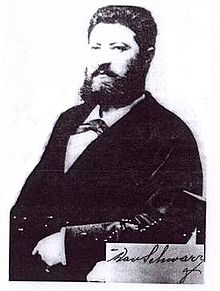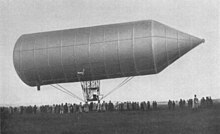David Black
David Schwarz (born December 7, 1850 in Keszthely , Austrian Empire , † January 13, 1897 in Vienna , Austria-Hungary ) was an aviation pioneer . He created the first metal airship.
Life
David Schwarz was born to Jewish parents in Keszthely in the Kingdom of Hungary . In 1880 he married Melanie Kaufmann, the daughter of a Jewish inn owner. In Agram he ran a flour agency from 1890-1891. His daughter was the opera and operetta singer Vera Schwarz .
Schwarz is said to have only attended elementary school and completed a commercial apprenticeship in Županja . He did not have any special technical training, but he was intensively self-taught with technology and developed various improvements for wood cutting machines, for example.
The idea
It was only in the 1880s that Schwarz began to deal with airships. The occasion was his stay in a log cabin in Croatia at the beginning of winter. There he supervised the logging work in a newly bought forest. When the work took longer than planned, Schwarz had his wife from Agram send him literature to pass the time in the evening. Since Charles Dickens and Victor Hugo did not please him, as can be seen in a letter from his wife, she sent him a work by Aristotle and a textbook on mechanics . It is not entirely clear what inspired Schwarz to build his own airship. From now on, however, he pursued this thought intensively. The timber business suffered and he, like many other aviation pioneers, earned a lot of ridicule for his project. However, his wife Melanie supported him as much as possible. At that time, Schwarz was already working on the use of aluminum for construction, a material that was new at the time.
In Russia
After David Schwarz had worked out the construction of his all-metal airship, he offered his documents to the War Minister of Austria-Hungary in Vienna . The idea met with interest, but no one was willing to provide funding for this project.
The Russian military attaché in Vienna, Colonel Sujew, recommended Schwarz to present his airship concept in St. Petersburg . After negotiations with the Russian War Ministry, Schwarz began shipping the first aluminum parts of the planned airship, which were manufactured by Carl Berg in his factory in Germany, to Russia in 1892 . From 1893 onwards, the airship was designed in a two-year construction work based on Schwarz's ideas. In Wosduchoplawatelny Park ( Russian Воздухоплавательный парк ), a military test site, an airship hangar was built especially for this purpose . In the autumn of 1894 it turned out that the development costs had been exceeded drastically. Originally, the project was supposed to cost 1,500 rubles . Ultimately, however, the construction devoured 100,000 rubles. After this setback, the Russian military abandoned the airship project in October 1894.
It is controversial within the literature whether the airship made its maiden flight before the project was finished. Schwarz and later his widow also claimed that test drives were made there, but this could never be proven. Experts assume that there are problems with the filling of the float, it being unclear whether the gas quality was poor or whether there were structural problems. The circumstances of Schwarz's return are also unclear, but reports of a hasty departure from Russia are reported.
Back in Germany
In Germany, Schwarz, who was looking for an aluminum processor, won over the industrialist Carl Berg for his idea, who already had some experience in the processing and further development of the still new material aluminum and was later to supply construction parts for Zeppelin's first airship . At the time, Berg was one of two aluminum manufacturers in Germany. With his financial and technical help, the airship was finally planned and built.
In 1895 construction began on Tempelhofer Feld near Berlin. The Prussian airship department made their premises and temporarily staff available for this. The parts were produced in Carl Berg's factory in Eveking / Westphalia and assembled in Berlin under the guidance of Schwarz.
However, Schwarz did not live to see the successful maiden flight of his ship. From 1892 to 1896 he traveled a lot, which must have been a physical strain on him, and he was also addicted to nicotine. On January 13, 1897, he collapsed on the street in front of the “Zur Linde” restaurant in Vienna and died a few minutes later of heart failure in a hallway. Historical sources speak of a hemorrhage . Shortly before, he had received the message that his airship was ready to be filled with gas.
The Jewish community of the city of Vienna honored David Schwarz with an honorary funeral and with a tomb in the central cemetery .
After the death of Schwarz
His wife Melanie, who is described as an energetic and clever woman, then had great difficulties in bringing the promising project to a conclusion. In particular, the military refused to cooperate because it was a “Jewish thing”, so that initially no pilot could be found for the test flight. After all, she was able to win Ernst Jagels over for it.
The Schwarz airship
The Schwarzsche airship was the first all-metal airship in the world. Except for the US ZMC-2 from the 1930s, no other ship of this design has soared into the air. However, the idea was not new; Georg Baumgarten already "patented" it in one of his patents.
The ship consisted of a rigid buoyancy structure with an internal structure to which the nacelle was firmly attached. Both were features of an airship that were previously unknown. The length of the float was 38.32 m. The shell consisted of 0.18 to 0.20 millimeter thick aluminum sheets, which were folded and riveted airtight and stretched over the inner aluminum construction. The main element of the float was a cylinder 12 m in diameter and 24.32 m in length. At the rear of the stern, the cylinder was closed off by a spherical cap 3 m high (here: length), the bow was formed by an 11 m long cone. The entire body was divided into 13 segments (gas cells), each with its own filling opening at the bottom.
The inner scaffolding was also 24.32 m long, 8 m wide and consisted of two longitudinal lattice girders with two parallel intermediate girders and ten cross girders (all on one level) The girders consisted of 200 mm lattice and were made of 20 × 20 × 2- mm angles have been built. The nacelle hung on four lattice girders, which were attached to two cross members of the main frame, with the lower edge about 4.4 m below the float. It was tied to other girders with ropes or wires. The drive consisted of a 16 hp Daimler engine, from the point of view of the time it was a high-performance engine. It drove two external propellers with a diameter of 2 m each and a propeller at the end of the nacelle with a diameter of 2.6 meters. The motor was also connected to a 2 m propeller under the nacelle floor via an angular gearbox, which was supposed to provide vertical thrust .
Completion of the ship
After delays, the ship was filled with gas for the first time on October 9, 1896, but the result was not satisfactory because the hydrogen gas supplied by the United Chemical Factories from Leopoldshall (near Staßfurt ) was not of the required quality and therefore did not generate enough buoyancy. It was calculated with 1.15 kg / m³. Gas of sufficient quality could only be supplied from January 13, 1897, the anniversary of Schwarz's death.
The first and only ride
On November 3, 1897, a rigid airship took to the skies for the first time in Tempelhof near Berlin . It reached a height of 400 m. Since the drive belts jumped off the pulleys and the controls failed as the speed decreased, the airship had to make an emergency landing and broke in the process. The pilot suffered only minor injuries.
Graf Zeppelin was among the spectators and successfully pushed the development from black - modified - to the Zeppelin.
The Tempelhofer Feld was the training area of the Berlin garrison in 1896 , the army airship had received a training area here from 1885.
Individual evidence
- ↑ David Schwarz. In: drzavno2012.pgsri.hr. April 26, 2012, accessed November 16, 2015 . - Creation date uncertain
- ↑ Helmut Braun: The rise and fall of airship travel - an economic historical analysis. eurotrans-Verlag, Regensburg 2007, ISBN 3-936400-22-9 , p. 177 f.
- ↑ https://mercedes-benz-publicarchive.com/marsClassic/de/instance/ko/Ganzmetallluftschiff-startet-zu-seiner-Jungfernfahrt.xhtml?oid=4909572
- ↑ Hans-Peter Papke: Imprint and disclaimer peterpapke.de, around October 2008
literature
- Karl-Dieter Seifert: Black, David. In: New German Biography (NDB). Volume 23, Duncker & Humblot, Berlin 2007, ISBN 978-3-428-11204-3 , p. 805 f. ( Digitized version ).
- Ch. Mentschl: Black David. In: Austrian Biographical Lexicon 1815–1950 (ÖBL). Volume 11, Verlag der Österreichischen Akademie der Wissenschaften, Vienna 1999, ISBN 3-7001-2803-7 , p. 429 f. (Direct links on p. 429 , p. 430 ).
- Carl Berg: David Schwarz, Carl Berg, Graf Zeppelin: A contribution to the history of Zeppelin airship travel in Germany ; Self-published; Munich 1926
- Cvi Rotem: David Schwarz, Tragedy of the Inventor ; 1983 manuscript
- Eckhard Trox (ed.): The dream of flying. Carl Berg and the airship idea from Lüdenscheid to Lakehurst. (Research on the history of Prussia in southern Westphalia, vol. 4). Lüdenscheid, 2000
- G. Bresonik, David Schwarz - Carl Berg - Graf Zeppelin, A contribution to the early history of the rigid airship, in: Zeppelin and France. Scenes of a love-hate relationship (Ed. W. Meighörner), Friedrichshafen 1998, pp. 42–57
Web links
- Ante Sucur: The Airship of David Black ( English ) Retrieved on 19 October of 2009.
- Ante Sucur: The Airship of David Schwarz / The Construction and Testing of the Airship ( English ) 2008. Archived from the original on May 6, 2008. Retrieved on February 11, 2011.
- Portrait of David Schwarz on hkv.hr
| personal data | |
|---|---|
| SURNAME | Black, David |
| BRIEF DESCRIPTION | Airship designer |
| DATE OF BIRTH | December 7, 1850 |
| PLACE OF BIRTH | Keszthely |
| DATE OF DEATH | January 13, 1897 |
| Place of death | Vienna |


